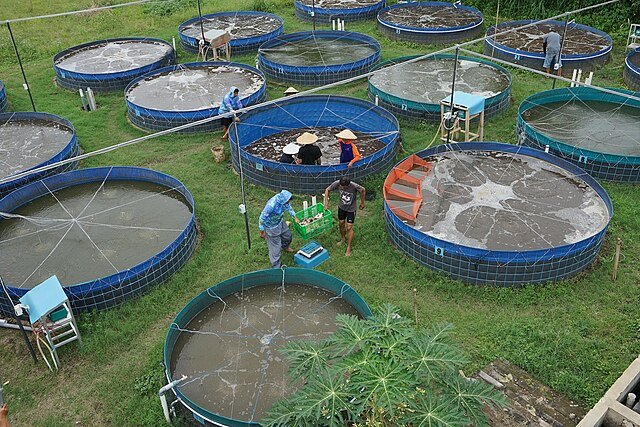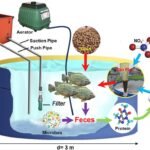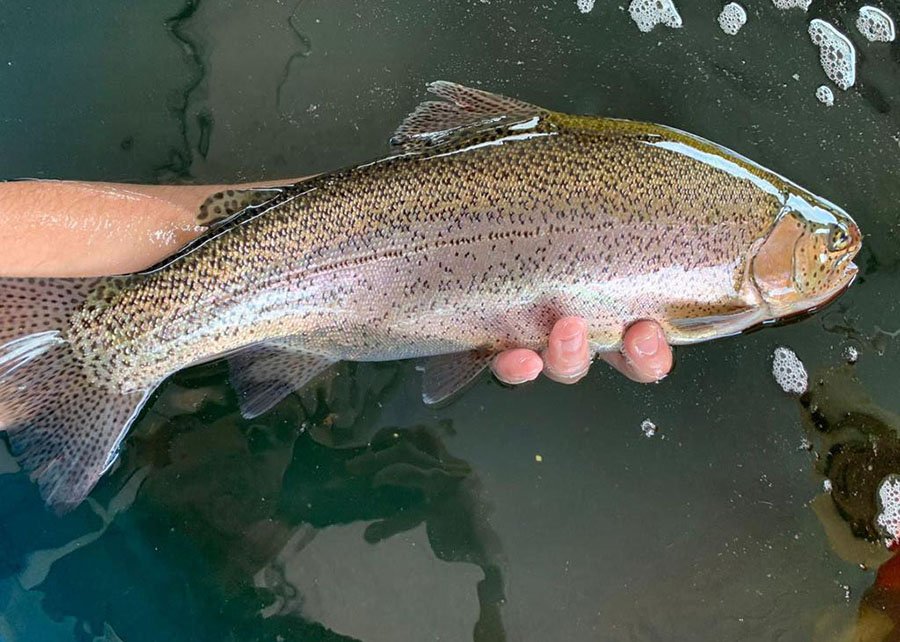
Biofloc Technology (BFT) is a promising approach that utilizes natural microorganism flocs to improve water quality. However, these beneficial microbes need a food source to thrive.
Scientists from Huzhou University (China) investigated the effects of different concentrations of fructooligosaccharide (FOS) instead of glucose (GLU) as a carbon source in the biofloc system. They used GLU as the control group’s carbon source and 2.5%, 5.0%, 7.5%, and 10.0% FOS instead of GLU as the carbon source in the experimental groups.
Fructooligosaccharides (FOS)
FOS, also known as oligofructoses or oligofructans, are prebiotics, natural sugars formed by glucose and fructose molecules, found in fruits and vegetables (banana, asparagus, onion, artichokes, etc.).
The prebiotic function of FOS promotes the growth of bacteria such as bifidobacteria and lactobacilli. Additionally, research has reported that fructooligosaccharides have been used as a strategy to increase tilapia immunity and as prebiotics.
The Power of FOS in Biofloc Systems
Researchers compared the effects of different concentrations of FOS (2.5%, 5.0%, 7.5%, and 10.0%) with a control group that used glucose (GLU) as the carbon source. All FOS groups effectively reduced ammonia, nitrite, nitrate, and total nitrogen levels in the water. This is crucial for maintaining a healthy environment for fish and other aquatic life.
The findings revealed several advantages of using FOS:
- Improved Water Quality: All FOS concentrations effectively reduced ammonia, nitrite, nitrate, and total nitrogen levels in the water. This translates to a cleaner and healthier environment for aquatic organisms.
Changing the Microbial Landscape
The study also analyzed the microbial communities within the biofloc systems. Interestingly, FOS supplementation caused significant changes:
- Increase in Beneficial Bacteria: The abundance of Flavobacterium, known for their role in nutrient cycling and biodegradation, significantly increased in the 2.5% FOS group. Similarly, Acinetobacter, another group of beneficial bacteria, thrived in the 10.0% FOS group.
- Reduction in Harmful Bacteria: The abundance of Aeromonadaceae, a group of bacteria that can be pathogenic to fish, significantly decreased in all FOS groups compared to the control.
These findings suggest that FOS can promote a healthier microbial balance within the biofloc system, favoring beneficial bacteria that contribute to improved water quality.
Stay Always Informed
Join our communities to instantly receive the most important news, reports, and analysis from the aquaculture industry.
Optimal FOS Concentration
The study suggests that a 2.5% FOS concentration offers the most balanced benefits. It promotes the growth of key bacteria while keeping costs manageable. This finding paves the way for a more sustainable and cost-effective approach to using biofloc technology.
The Road Ahead
This research lays the foundation for further exploration of FOS in BFT systems. Future studies can delve deeper into the specific mechanisms by which FOS influence bacterial communities and optimize their use for various aquaculture applications.
Conclusions
“The replacement of GLU with 2.5% FOS as a carbon source in the biofloc system significantly increased the abundance of core bacteria (Flavobacterium and Acinetobacter) and significantly reduced harmful bacteria (Aeromonadaceae), thus stabilizing bacterial communities within the aquatic environment,” the researchers conclude.
Thus, the main conclusions of the study are:
- Fructooligosaccharides can be a viable alternative to glucose as a carbon source in BFT.
- FOS promote beneficial bacteria and reduce harmful ones, improving water quality.
- A 2.5% fructooligosaccharide concentration appears to be the most cost-effective option.
- More research is needed to fully understand the potential of FOS in aquaculture.
By adopting innovative techniques such as BFT enhanced with FOS, we can ensure a more sustainable and productive future for aquaculture, contributing to a healthier food system for all.
The project was funded by the Zhejiang Provincial Natural Science Foundation of China and the Zhejiang Province Agricultural Major Technology Cooperative Promotion Plan.
Contact
Rongfei Zhang
Email: rfzh@zjhu.edu.cn
Qiyou Xu
Email: xuqiyou@sina.com
Reference
Zhou, H., Wei, J., Tao, M. et al. Effects of replacing glucose with fructooligosaccharide on microbial community structure in biofloc system. Aquacult Int (2024). https://doi.org/10.1007/s10499-024-01572-7
Editor at the digital magazine AquaHoy. He holds a degree in Aquaculture Biology from the National University of Santa (UNS) and a Master’s degree in Science and Innovation Management from the Polytechnic University of Valencia, with postgraduate diplomas in Business Innovation and Innovation Management. He possesses extensive experience in the aquaculture and fisheries sector, having led the Fisheries Innovation Unit of the National Program for Innovation in Fisheries and Aquaculture (PNIPA). He has served as a senior consultant in technology watch, an innovation project formulator and advisor, and a lecturer at UNS. He is a member of the Peruvian College of Biologists and was recognized by the World Aquaculture Society (WAS) in 2016 for his contribution to aquaculture.




